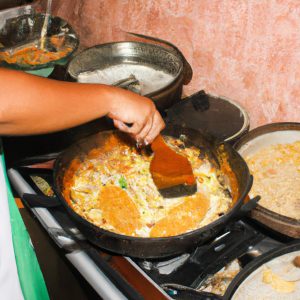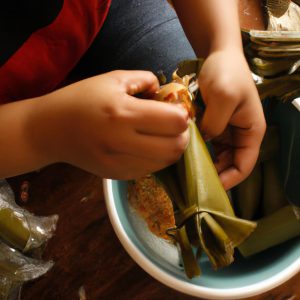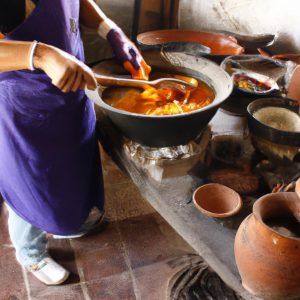Mexican cuisine is renowned for its vibrant flavors and diverse range of ingredients. From the spicy kick of chilies to the earthy richness of corn, these essential components form the foundation of traditional Mexican dishes. Exploring the key elements that define Mexican cuisine is not only an exercise in culinary appreciation but also a journey into the cultural heritage and history of Mexico.
One example that exemplifies the significance of essential ingredients in Mexican cuisine is the iconic dish, mole poblano. Mole poblano is a complex sauce made from a combination of chili peppers, chocolate, nuts, seeds, spices, and various other ingredients. This rich and flavorful sauce represents the fusion of indigenous and Spanish influences on Mexican cooking. By examining this classic recipe alongside other staples such as tortillas, beans, avocados, and tomatoes – it becomes evident that understanding the essential ingredients is crucial to appreciating and replicating authentic Mexican flavors.
In this article, we will delve into some of the indispensable elements that make up Mexican cuisine. We will explore how each ingredient contributes to creating distinctive tastes and textures while uncovering their historical origins within Mexico’s diverse culinary traditions. By gaining insight into these essential building blocks, readers can develop a deeper understanding of what makes Mexican cuisine so unique and beloved among food enthusiasts around the world.
Spicy Flavors: Fresh Chilies
Imagine biting into a delicious Mexican dish, feeling the burst of flavors dancing on your taste buds. One of the key ingredients responsible for this explosion of taste is fresh chilies. Whether you prefer mild or fiery heat, there is a chili pepper to suit every palate in Mexican cuisine.
The use of fresh chilies in Mexican dishes dates back centuries, and their importance cannot be overstated. These vibrant peppers are not only known for their spiciness but also for the complex flavors they bring to a dish. From smoky notes to fruity undertones, each variety of chili adds its own distinct personality to the culinary masterpiece.
To fully appreciate the significance of fresh chilies in Mexican cuisine, let us explore some examples:
- Case Study: Salsa Roja – A traditional salsa made with ripe tomatoes, onions, garlic, cilantro, and serrano peppers. The moderate heat from these chilies allows other ingredients to shine while adding a delightful kick.
Now let’s delve deeper into why fresh chilies hold such prominence by considering their impact:
- Excitement: Fresh chilies inject excitement into any dish with their spicy nature.
- Variety: There exists an array of chili varieties like jalapeños, poblanos, habaneros and more that cater to different levels of spice tolerance.
- Depth: Beyond providing heat, fresh chilies contribute layers of flavor that enhance the overall profile of a dish.
- Cultural heritage: Fresh chilies have been integral to Mexican cuisine for generations and embody the rich cultural heritage associated with these delectable dishes.
| Chili Variety | Heat Level (Scoville units) | Flavor Profile |
|---|---|---|
| Jalapeño | 2,500 – 8,000 | Mild and earthy |
| Serrano | 10,000 – 23,000 | Crisp and bright |
| Habanero | 100,000 – 350,000 | Intensely fruity |
As we delve further into the realm of Mexican cuisine, we will discover yet another essential ingredient: Creamy and nutritious avocados. These versatile fruits play a vital role in balancing out the heat from fresh chilies while adding a delightful creaminess to dishes.
Creamy and Nutritious: Avocados
Continuing our exploration of essential ingredients in Mexican cuisine, we now turn our attention to the creamy and nutritious avocado. This versatile fruit adds a rich texture and subtle flavor to countless dishes, making it an indispensable component of traditional Mexican recipes.
Avocado’s Versatility:
One example that showcases the versatility of avocados is the classic Guacamole. By mashing ripe avocados with lime juice, diced tomatoes, onions, and cilantro, this beloved dip becomes a crowd-pleaser at any gathering. However, avocados go beyond just being an accompaniment; they can be incorporated into various meals as well. From spreading mashed avocado on toast for a hearty breakfast to using it as a base for dressings or sauces, the possibilities are endless.
Health Benefits & Emotional Response:
When considering the health benefits of avocados, one cannot help but feel inspired by their nutrient-rich profile. Let us take a moment to reflect upon some key aspects:
- Rich in heart-healthy monounsaturated fats
- Packed with dietary fiber for improved digestion
- Abundance of essential vitamins like vitamin K and vitamin E
- Contains antioxidants that support overall wellness
Table: Health Benefits of Avocado
| Benefit | Description |
|---|---|
| Heart Health | Monounsaturated fats promote cardiovascular health |
| Digestive Wellness | Fiber aids in smooth digestion |
| Nutrient Powerhouse | Vitamins contribute to overall well-being |
| Antioxidant Support | Protects against oxidative stress |
These remarkable qualities not only appeal to our taste buds but also inspire feelings of vitality and nourishment.
With its ability to elevate both savory and sweet dishes alike, avocados have become synonymous with Mexican cuisine. However, there is another ingredient whose presence brings herbal freshness and complexity to these culinary creations – cilantro. Let us now embark on a journey exploring this vibrant herb’s unique contribution.
Herbal Freshness: Cilantro
Having explored the creamy goodness of avocados, we now turn our attention to another essential ingredient in Mexican cuisine that adds a burst of herbal freshness to dishes – cilantro. Let’s delve into the unique qualities and culinary uses of this vibrant herb.
Section:
Cilantro, also known as coriander or Chinese parsley, is widely recognized for its distinct flavor profile and aromatic qualities. Its delicate leaves possess a citrusy and slightly peppery taste with hints of earthiness, making it an indispensable component in various Mexican dishes. For instance, imagine savoring a bowl of freshly made salsa verde on a warm summer day. The sharp tanginess from lime juice combined with the vibrant green color derived from blended tomatillos would be incomplete without the refreshing addition of chopped cilantro leaves.
To truly appreciate cilantro’s role in enhancing Mexican cuisine, let us consider some key aspects:
-
Versatility:
- It can be used both as a garnish and as an integral ingredient.
- Adds depth of flavor when incorporated into sauces, marinades, and dressings.
- Perfect complement to seafood dishes like ceviche or fish tacos.
-
Health Benefits:
- Rich in antioxidants that contribute to overall well-being.
- Natural source of dietary fiber, vitamins A and K, potassium, and folate.
- May aid digestion due to its potential antimicrobial properties.
-
Culinary Pairings:
- Combines exceptionally well with other traditional Mexican ingredients such as lime,
jalapeños, onions, garlic, and tomatoes. - Balances flavors by adding brightness to rich or spicy dishes.
- Combines exceptionally well with other traditional Mexican ingredients such as lime,
-
Cultural Significance:
Symbol of Prosperity Celebration Familial Bonding Represents good luck Festive occasions Passed-down recipes Associated with love Shared meals Cultural identity
Cilantro’s vibrant presence in Mexican Cuisine not only enhances the flavor and aroma of various dishes but also carries cultural significance. Its rich history and versatility make it an essential herb that embodies the spirit of Mexican culinary traditions.
limes. The tangy acidity they provide adds a refreshing twist to numerous traditional recipes without overpowering the other flavors at play.
Citrus Zing: Limes
Having explored the vibrant flavors of cilantro, we now turn our attention to another essential ingredient in Mexican cuisine – limes. Known for their citrus zing and refreshing taste, limes play a crucial role in enhancing the overall flavor profile of many traditional Mexican dishes.
When it comes to adding that perfect tangy kick to your favorite Mexican recipes, limes are an indispensable ingredient. Imagine savoring a plate of freshly made guacamole, where the creamy texture is perfectly balanced by the bright acidity of lime juice. This classic example highlights just how vital limes are in achieving that authentic burst of flavor associated with Mexican cuisine.
To fully appreciate the significance of limes in Mexican cooking, let’s delve into some key aspects about this versatile fruit:
- Versatility: Limes can be used in various ways throughout different stages of meal preparation. From squeezing fresh lime juice over finished dishes as a final touch, to incorporating its zest into marinades or dressings, limes offer a range of culinary possibilities.
- Health benefits: Rich in Vitamin C and antioxidants, consuming limes not only enhances flavor but also contributes positively to one’s health. The natural acidity aids digestion and can even help prevent certain foodborne illnesses.
- Cultural symbolism: In addition to their practical uses, limes hold cultural significance within Mexican traditions. They often symbolize purity and cleansing rituals during celebrations such as Día de los Muertos (Day of the Dead) or Las Posadas.
Let’s take a closer look at some interesting facts about limes:
| Fact 1 | Lime trees originated in Southeast Asia and were brought to Mexico by Spanish conquistadors. |
| Fact 2 | Mexico is one of the world’s largest producers of limes, with varieties such as key lime and Persian lime being widely cultivated. |
| Fact 3 | Lime juice can be used not only in beverages but also as a natural meat tenderizer due to its acidity. |
| Fact 4 | The zest of limes adds an aromatic twist to desserts like traditional Mexican flan or refreshing sorbets. |
In summary, the vibrant flavor profile and cultural significance make limes an essential ingredient in Mexican cuisine. From their versatile culinary applications to their health benefits and symbolic importance, limes bring that citrus zing which elevates dishes to new heights.
Moving forward, let us now delve into another intriguing herb commonly found in Mexican kitchens – epazote – renowned for its distinctive aroma and unique contribution to various traditional recipes.
Distinctive Aroma: Epazote
Moving on from the tangy zest of limes, we now delve into another essential ingredient that gives Mexican cuisine its distinctive aroma: epazote. Imagine a steaming bowl of traditional black bean soup, infused with an earthy scent that tickles your senses and transports you to the heart of Mexico. This is precisely what epazote brings to countless dishes in Mexican cuisine.
Epazote, scientifically known as Dysphania ambrosioides, is an herb native to Central America and parts of Southern Mexico. Its unique flavor profile enhances various recipes, making it a staple in authentic Mexican cooking. One notable example where epazote shines is in the preparation of Oaxacan-style mole negro, a rich and complex sauce made with chocolate and chiles. The addition of epazote adds depth to this iconic dish, balancing out the sweetness and spice with its pungent notes.
To better understand the significance of epazote in Mexican cuisine, let’s explore some key characteristics associated with this aromatic herb:
- Distinctive aroma: Epazote emits a strong fragrance reminiscent of citrus and mint, which intensifies when heated or crushed.
- Medicinal properties: Beyond its culinary uses, epazote has been valued for centuries due to its potential medicinal benefits such as aiding digestion and relieving flatulence.
- Traditional pairings: Epazote pairs exceptionally well with ingredients like beans, corn masa dough (used for tortillas), soups, stews, tamales, and quesadillas.
- Cultural symbolism: In addition to its culinary importance, epazote holds cultural significance in indigenous communities throughout Mexico. It has been used ceremonially and believed to possess protective qualities.
The table below showcases some popular dishes where epazote plays a vital role:
| Dish | Description |
|---|---|
| Black Bean Soup | Epazote adds a distinctive flavor to this classic Mexican soup, elevating it from simple to extraordinary. |
| Tamales | Traditionally wrapped in corn husks or banana leaves, tamales are filled with various ingredients and steamed until tender. Epazote brings an aromatic touch to the masa dough and infuses the filling with its unique taste. |
| Pozole | This hearty stew combines hominy (dried maize kernels) with meat and spices, creating a flavorful dish enjoyed during festive gatherings. Epazote adds depth and complexity to the broth, enhancing the overall experience. |
| Quesadillas de Flor de Calabaza | Stuffed with squash blossoms and melted cheese, these quesadillas receive an extra boost of aroma when cooked alongside epazote leaves. |
As we explore further into the realm of Mexican flavors, our next stop is the introduction of another herb that imparts an exceptional taste: Mexican oregano. With its robust profile and ability to elevate dishes effortlessly, this herb holds great importance in traditional Mexican fare.
Flavorful Herb: Mexican Oregano
Epazote, a highly aromatic herb commonly used in Mexican cuisine, adds a unique flavor profile to various dishes. One example of its application is in the traditional dish called ‘frijoles de olla,’ which translates to “pot beans.” These slow-cooked beans are infused with epazote, giving them an earthy and slightly citrusy taste.
To fully appreciate the significance of epazote in Mexican cuisine, it is essential to understand its distinct characteristics and benefits. Here are four key attributes that make epazote a staple ingredient:
-
Strong scent: The pungent aroma of epazote has made it synonymous with Mexican cooking. When added to a simmering pot of beans or soups, the fragrance fills the kitchen, creating an inviting atmosphere.
-
Digestive properties: Epazote contains certain compounds known for their digestive benefits. Historically, this herb has been used as a natural remedy for gastrointestinal discomfort and gas prevention.
-
Culinary versatility: While most commonly associated with bean-based dishes, epazote also complements other ingredients like corn and chiles. Its ability to enhance flavors makes it suitable for various recipes beyond just stews and soups.
-
Cultural significance: Beyond its culinary applications, epazote holds cultural importance among indigenous communities in Mexico. It is often referred to as “the poor people’s seasoning” due to its affordability and accessibility.
Table showcasing different uses of Epazote:
| Dish | Description |
|---|---|
| Frijoles de Olla | Slow-cooked pot beans infused with epazote |
| Salsa Verde | Green salsa made from fresh ingredients such as tomatillos |
| Tamales | Traditional corn masa pockets filled with savory fillings like chicken or pork |
| Enchiladas | Rolled tortillas filled with various ingredients, topped with sauce and cheese |
As we delve into the diverse world of Mexican cuisine, it becomes evident that epazote is just one piece of a larger puzzle. In the subsequent section on “Flavorful Herb: Mexican Oregano,” we will explore another essential ingredient that contributes to the richness and authenticity of this vibrant culinary tradition.
Traditional Mexican Spices
Mexican Cuisine: essential ingredients
Flavorful Herb: Mexican Oregano
In the previous section, we explored the unique characteristics and culinary uses of Mexican oregano. Now, let’s delve into another essential aspect of Mexican cuisine — traditional spices that add depth and complexity to dishes.
Traditional Mexican Spices
To illustrate the significance of these spices, imagine a traditional mole sauce being prepared in a bustling kitchen. The chef carefully selects an assortment of dried chili peppers, such as ancho, guajillo, and pasilla. Each pepper contributes distinct flavors and levels of heat to the sauce. Along with these chilies, a medley of other spices like cumin, cinnamon, cloves, and coriander seeds are added to create a harmonious blend that complements various ingredients.
The use of traditional Mexican spices serves multiple purposes:
- Enhancing Flavor: These spices contribute unique tastes and aromas that elevate dishes beyond ordinary meals.
- Preserving Food: Historically, many Mexican spices were used for their antimicrobial properties, allowing food to be stored for longer periods without spoiling.
- Health Benefits: Some traditional Mexican spices have been found to possess medicinal qualities due to their high antioxidant content or anti-inflammatory properties.
- Cultural Significance: Incorporating these authentic spices not only adds flavor but also pays homage to Mexico’s rich culinary heritage.
To further understand the role of traditional Mexican spices in enhancing flavors and adding depth to dishes, consider this table showcasing some commonly used ones:
| Spice | Flavor Profile | Culinary Uses |
|---|---|---|
| Cumin | Earthy, nutty | Soups, stews, sauces |
| Paprika | Mildly spicy | Marinades, spice rubs |
| Cinnamon | Sweet, warm | Baked goods, desserts |
| Cloves | Strong, pungent | Ham glazes, pickling spices |
In summary, the extensive use of traditional Mexican spices is a testament to the complexity and depth found within this vibrant cuisine. By incorporating these flavorsome ingredients into their dishes, cooks can evoke emotions and create memorable culinary experiences for themselves and others.
Versatile Ingredients
Traditional Mexican Spices create a distinctive flavor profile that is essential to authentic Mexican cuisine. These spices are used in various dishes, adding depth and complexity to the flavors. Let’s explore some of the most commonly used traditional Mexican spices.
One notable example is the use of cumin, which imparts an earthy and warm aroma to many Mexican dishes. For instance, in a classic chili con carne recipe, cumin acts as a key spice that enhances the overall taste. It not only adds a distinct smoky flavor but also balances out the heat from other ingredients like chili peppers.
When it comes to traditional Mexican cooking, there are several must-have spices that play vital roles in creating delicious meals:
- Chili Powder: Made from ground dried chilies, this spice gives dishes their signature kick while providing rich color.
- Oregano: Mexican oregano has a slightly citrusy and floral taste, which sets it apart from its Mediterranean counterpart. It adds freshness and complements other herbs.
- Paprika: This vibrant red spice adds both color and mild sweetness to various recipes such as stews, marinades, and sauces.
- Epazote: Known for its unique pungent aroma reminiscent of licorice or mint, epazote is often used in bean-based dishes to aid digestion.
To further illustrate the role of these spices in Mexican cuisine, consider the following table:
| Spice | Flavor Profile | Common Use |
|---|---|---|
| Cumin | Earthy, Smoky | Chili con carne |
| Chili Powder | Spicy | Salsa roja |
| Oregano | Citrusy, Floral | Mole sauce |
| Paprika | Mild Sweetness | Pozole |
| Epazote | Pungent | Black beans (frijoles de la olla) |
These spices, along with many others, contribute to the vibrant and enticing taste of Mexican cuisine. They bring a harmonious blend of flavors that elevate every dish they are used in.
Moving forward into our next section on “Versatile Ingredients,” we will explore how these traditional Mexican spices work synergistically with other essential components to enhance the overall flavor profile and culinary experience. By understanding their unique properties, we can unlock a world of possibilities in the kitchen without compromising authenticity or taste.
Enhancing the Taste of Dishes
When it comes to Mexican cuisine, incorporating various ingredients is key in elevating the taste and creating a delightful culinary experience. Let’s explore how these ingredients can be utilized to enrich the taste of traditional Mexican dishes.
Imagine a classic dish like enchiladas with a twist—a creamy poblano sauce drizzled over tender chicken-filled tortillas. This flavorful creation showcases how combining different essential components can result in an exquisite dining experience. To achieve this, chefs often employ the following techniques:
-
Spices and Herbs:
- Cumin
- Oregano
- Epazote
- Chipotle peppers
-
Sauces and Salsas:
- Mole sauce
- Tomatillo salsa
- Habanero hot sauce
- Pico de gallo
-
Aromatics:
- Garlic
- Onion
- Cilantro
- Lime zest
-
Seasonings:
- Sea salt
- Black pepper
- Smoked paprika
- Adobo seasoning blend
These carefully selected elements come together harmoniously, infusing each bite with layers of flavor that awaken the senses. By skillfully balancing spices, sauces, aromatics, and seasonings, chefs make sure that every ingredient contributes its unique essence without overpowering the overall composition.
To illustrate this further, consider the table below showcasing some popular Mexican dishes alongside their standout flavors:
| Dish | Standout Flavors |
|---|---|
| Tacos al Pastor | Tangy pineapple marinade |
| Chiles Rellenos | Rich roasted poblano peppers |
| Pozole | Hearty hominy broth |
| Mole Poblano | Complex chocolate-infused sauce |
As evident from this table, Mexican cuisine is a tapestry of flavors that range from tangy and spicy to rich and complex. The careful selection and combination of essential ingredients allow each dish to possess its own unique identity.
Transitioning into the next section about the key elements of Mexican cuisine, it becomes clear that enhancing flavors through versatile ingredients is just one facet of what makes this culinary tradition so remarkable. By delving deeper into the core components of Mexican cooking, we can gain a comprehensive understanding of its rich heritage and diverse techniques.
Key Elements of Mexican Cuisine
Imagine a traditional Mexican dish bursting with flavors that transport your taste buds to the vibrant streets of Mexico City. To achieve such culinary excellence, it is crucial to understand the key elements that enhance the taste of Mexican cuisine. From aromatic spices to tangy citrus fruits, these ingredients not only add depth but also create an unforgettable sensory experience.
One essential ingredient in Mexican cooking is chili peppers. They come in various shapes, sizes, and heat levels, adding complexity and spiciness to dishes. For instance, using serrano peppers in a salsa verde can provide a mild yet flavorful kick, while habanero peppers can bring intense heat to fiery salsas or marinades.
Another vital component is cilantro. This herb has a distinct flavor profile reminiscent of citrus and adds refreshing notes to many Mexican recipes. Pairing it with lime juice creates a zesty combination that elevates guacamole or pico de gallo.
To further enhance the taste of dishes, Mexicans often incorporate dried herbs and spices like cumin and oregano. These fragrant additions infuse their unique aromas into stews, soups, and meat rubs. The combination of toasted cumin seeds with ground coriander creates a warm earthy undertone perfect for seasoning meats or crafting intricate mole sauces.
Mexican Cuisine: Essential Ingredients
Previous section H2: Enhancing the Taste of Dishes
Next section H2: Adding Depth to Recipes
As we delve deeper into Mexican cuisine, understanding its core components lays the foundation for creating authentic and delicious meals. Now let us explore how these fundamental ingredients are utilized alongside other techniques to add depth and complexity to traditional recipes without overpowering their original essence.
Adding Depth to Recipes
In the previous section, we explored the key elements that define Mexican cuisine. Now, let’s delve deeper into how these elements can add depth to your recipes and enhance the flavors in your dishes.
Imagine you are preparing a traditional Mexican dish such as enchiladas. By understanding the essence of Mexican cuisine, you can elevate this classic recipe by incorporating essential ingredients and techniques. For example, instead of using store-bought tortillas, consider making homemade corn tortillas from scratch. This small change will not only provide a fresher taste but also showcase your dedication to authenticity.
To truly capture the vibrant spirit of Mexican cooking, it is crucial to embrace a diverse range of flavors and textures. Here are four important aspects to consider when adding depth to your recipes:
- Spices: The use of spices like cumin, oregano, and chili powder adds complexity and warmth to many Mexican dishes.
- Fresh Herbs: Cilantro and epazote bring freshness and aroma to salsas, soups, and stews.
- Citrus Fruits: Limes and oranges lend a tangy brightness that balances rich or spicy flavors.
- Chiles: From mild poblano peppers to fiery habaneros, chiles play a central role in Mexican cuisine, providing heat and distinctive flavor profiles.
Now let’s take a closer look at how these elements come together by exploring their characteristics through this table:
| Element | Flavor Profile | Usage |
|---|---|---|
| Spices | Earthy, warm | Enhance savory dishes |
| Fresh Herbs | Bright, aromatic | Add freshness to salsas and soups |
| Citrus Fruits | Tangy, refreshing | Balance richness or spice |
| Chiles | Varied (from mild to hot) | Provide heat and unique flavors |
By incorporating these elements into your cooking, you can create a harmonious balance of flavors that is characteristic of Mexican cuisine. The versatility of these ingredients allows for endless combinations, ensuring each dish remains exciting and enticing.
Understanding how to incorporate these distinct tastes will further enhance your culinary repertoire in this vibrant cuisine. So let’s dive in and unlock the secrets behind the essential flavors in Mexican cooking.
Essential Flavors in Mexican Cooking
Building upon the concept of adding depth to recipes, it is crucial to explore the essential flavors that contribute to the authenticity and richness of Mexican cuisine. By understanding these core elements, one can create dishes that truly capture the essence of this vibrant culinary tradition.
Imagine a bowl of traditional Mexican guacamole – creamy avocados mashed with tangy lime juice, fragrant cilantro, spicy jalapenos, and a pinch of salt. Each ingredient plays a vital role in bringing forth a harmonious blend of flavors. Similarly, throughout Mexican cooking, there are several key components that form the foundation of countless dishes.
To delve deeper into the world of essential flavors in Mexican cooking, let us examine four fundamental ingredients:
-
Chili Peppers:
- These fiery peppers add heat and complexity to many Mexican dishes.
- Varieties such as jalapeno, serrano, or habanero offer different levels of spiciness.
- They lend not only heat but also unique flavor profiles to salsas, marinades, and stews.
-
Cilantro:
- This herb boasts a distinctive fresh and citrusy taste.
- It adds brightness and balance when used as an aromatic garnish or incorporated into sauces like salsa verde.
- Its presence often defines the authenticity of various regional cuisines within Mexico.
-
Lime:
- The acidic punch provided by lime juice enhances flavors while imparting a refreshing zing.
- From squeezing over tacos al pastor to marinating meats for grilling,
limes are indispensable in achieving that characteristic tang synonymous with Mexican food.
-
Epazote:
- This lesser-known herb has an earthy flavor reminiscent of oregano with hints of mint and citrus.
- Commonly used in traditional Mexican bean dishes, epazote adds a unique depth and complexity to stews and soups.
To further illustrate the importance of these essential flavors, consider the following table:
| Dish | Essential Flavors |
|---|---|
| Mole Poblano | Chili Peppers, Cilantro, Epazote |
| Tacos al Pastor | Chili Peppers, Lime |
| Salsa Verde | Chili Peppers, Cilantro |
| Pozole | Chili Peppers, Lime, Epazote |
This table showcases how different dishes incorporate the key elements mentioned above. The combination of various chili peppers alongside cilantro or lime creates distinct profiles that distinguish each dish within Mexican cuisine.
By recognizing the significance of these essential ingredients and understanding their roles in Mexican cooking, one can elevate culinary endeavors beyond mere replication. Armed with this knowledge, aspiring chefs and home cooks alike can immerse themselves fully in the rich tapestry of flavors that define authentic Mexican cuisine.











More Stories
Mexican Oregano: The Essential Ingredient in Mexican Food
Cilantro: The Essential Ingredient in Authentic Mexican Cuisine
Epazote: Discovering the Essential Mexican Food Ingredient